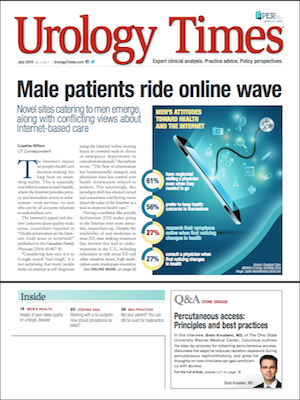Publication
Article
Urology Times Journal
Novel US ablation therapy shows significant PSA effect
Author(s):
A pivotal phase II trial of a novel MRI-guided ultrasound ablation treatment exceeded its primary efficacy endpoint of PSA decline in men with organ-confined prostate cancer.
Chicago-A pivotal phase II trial of a novel MRI-guided ultrasound ablation treatment exceeded its primary efficacy endpoint of PSA decline in men with organ-confined prostate cancer.
In the prospective, open-label study of MRI-guided transurethral ultrasound whole-gland ablation (TULSA-PRO), 96% of men had a PSA decrease of at least 75% at 1 year. Approximately 80% of the men who entered the study with Gleason grade group 2 (Gleason score 7) prostate cancer no longer had evidence of Gleason grade group 2 disease at 1 year. Nearly two-thirds of men had a complete histologic response based on biopsy, principal investigator Scott Eggener, MD, reported at the AUA annual meeting in Chicago.
Rates of severe treatment-related toxicity were low, said Dr. Eggener, director of the Prostate Cancer Program at the University of Chicago.
Also see -Prostate cancer in 9/11 responders: Study explores mechanism of action
The phase II study, conducted at 13 centers in the United States, Canada, and Europe, included 115 men with a median age of 65 years. Median pre-treatment PSA was 6.3 ng/mL and maximum PSA was 15.0 ng/mL. All men had Gleason grade group 2 or lower prostate cancer. Two-thirds of study participants had intermediate-risk disease, and the remainder had low-risk disease. More than 80% of men had Gleason grade group 2 or high-volume Gleason grade group 1 cancer, which is generally considered to be clinically meaningful disease, Dr. Eggener noted.
The intent of treatment was whole-gland ablation with sparing of the urethra and urinary sphincter. The procedure is performed entirely within the MRI suite under general anesthesia to eliminate motion. An ultrasound device, placed transurethrally under MRI guidance, continuously rotates and robotically delivers ultrasound waves peripherally to a predetermined contour around the prostate. Colorimetric feedback indicates when the target temperature of approximately 57 degrees Celsius is reached.
Following treatment, an MRI is provided to confirm the ablation margin. A suprapubic tube is placed for 2 weeks.
The procedure is capable of treating all sizes of prostates, Dr. Eggener said. It is not a form of high-intensity focused ultrasound, which is performed transrectally and has a different mechanism of applying ultrasound energy, he pointed out.
Next:Primary endpoint metPrimary endpoint met
In the current study, the primary endpoint of PSA reduction ≥75% was achieved in 110 of 115 men (96%). The FDA-approved protocol’s pre-established definition of success was a PSA decrease of ≥75% in 50% of patients.
“[The trial] overachieved on the PSA-based primary endpoint of what was considered success or failure,” Dr. Eggener said.
The median reduction in PSA was 95%. “Impressively, the median PSA nadir was 0.34 ng/mL. There was dramatic gland reduction,” Dr. Eggener said, with the pre-treatment median perfused prostate volume of 41 cc declining to 4 cc at 1 year following treatment-a 90% decrease.
In terms of safety, nine of 115 men (8%) experienced a grade 3 adverse event, with infection (4%) being the most common. One case each of urinary retention, urinoma, ileus, deep-vein thrombosis, urethral stricture, and urethral calculus was reported.
Of 112 patients on whom continence data were available at 1 year, 1% were incontinent (more than one pad per day). At 1 year, 3.8% of the men had a new increase in their daily leakage of urine.
At 1 year, 20% of men had grade 2 erectile dysfunction, and 69 of 92 (75%) who were potent prior to treatment maintained erections suitable for penetrative intercourse.
Among 68 men with pre-treatment intermediate-risk Gleason grade group 2 disease, 54 (79%) were free of Gleason grade group 2 disease on 1-year biopsy. Complete histologic response was seen in 72 off 111 patients (65%). Of 39 positive biopsies, 16 (41%) were clinically insignificant.
On multivariate analysis, three factors predicted the likelihood of ongoing presence of Gleason grade group 2 disease: presence of intraprostatic calcifications at screening, MRI thermal coverage of target volume, and PIRADS ≥3 lesion at 1-year post-treatment MRI (p<.05).
Read: Fat in abdomen, thigh linked to higher risk of aggressive prostate cancer
With the caveat that TULSA-PRO remains investigational, Dr. Eggener was asked which prostate cancer patient he would consider an ideal candidate if the treatment was granted regulatory approval.
“I would argue that it’s a guy who’s otherwise healthy, has Gleason 7 cancer, and understands the pros and cons of this approach,” he said. “Similar to other management options, it is not the ‘holy grail’; however, this could potentially be a nice addition to the menu of options for a guy that needs treatment, a menu that is getting larger and larger. Considerably more follow-up, trials, and data are required to better understand the long-term implications of this novel treatment modality.”
Profound Medical, the maker of the TULSA-PRO device, announced in May 2019 that its 510(k) application for premarket clearance cleared the FDA’s acceptance review. Follow-up will continue for 5 years.
Dr. Eggener is a paid consultant to Profound Medical.






















